Food and Beverage Services NC II
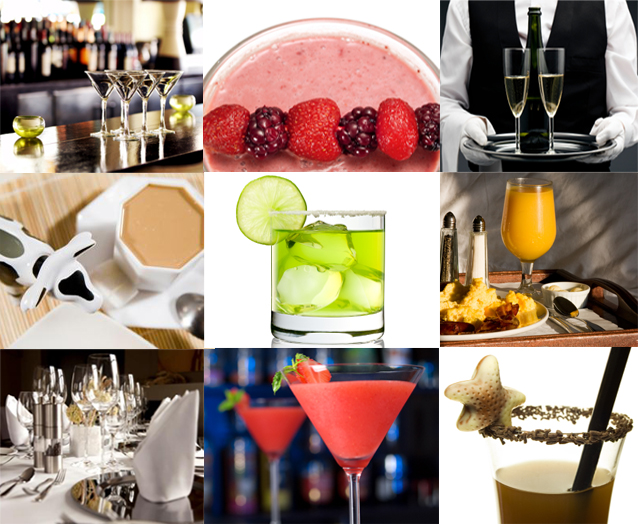
COURSE DESIGN
|
SUBJECT TITLE: |
FOOD AND BEVERAGE SERVICES NC II |
|
NOMINAL DURATION: |
160 HOURS |
|
SUBJECT DESCRIPTION: |
This course is designed to enhance the knowledge, skills and attitude in FOOD AND BEVERAGE SERVICES NC II in accordance with industry standards. It covers core competencies on cleaning bar areas, operating a bar, preparing and mixing of cocktails, providing link between kitchen and service areas, providing room service, providing food and beverage service, developing and updating of food and beverage knowledge and providing wine services. |
|
STUDENT ENTRY REQUIREMENTS: |
Student must possess the following qualifications, must be: · Able to communicate both oral and written. · Physically and mentally fit. · With good moral character. · Can perform basic mathematical and logical computations. · Analytical and logical thinking. |
COURSE STRUCTURE
|
Lesson 1: Introduction Food and Beverage Services Nominal Hours: 5 |
||
|
L.O. 1.1 |
Definition and Evolution of Food and Beverage Services |
|
|
L.O. 1.2 |
Types and Sectors of Food Service Industry |
|
|
L.O. 1.3 |
Food Service Method |
|
|
L.O. 1.4 |
Restaurant Service |
|
|
L.O. 1.5 |
Restaurant Lay-out |
|
|
Lesson 2: Organization and Responsibilities of Food and Beverage Operation Nominal Hours: 5 |
||
|
L.O. 2.1 |
Organizational Chart of Food and Beverage Industry |
|
|
L.O. 2.2 |
Associated Departments of Hotel Food Service |
|
|
L.O. 2.3 |
Professional Ethics for Good Food Service Personnel |
|
|
Lesson 3: Restaurant Equipment, Supplies and Table Appointments Nominal Hours: 10
|
||
|
L.O. 3.1 |
Service Equipment and Supplies in Restaurant Service |
|
|
L.O. 3.2 |
Table Appointments |
|
|
L.O. 3.3 |
Sanitation and Safety standards in handling food service equipment |
|
|
Lesson 4: Menu Nominal Hours: 5 Learning Objective: |
||
|
L.O. 4.1 |
Definition of Menu |
|
|
L.O. 4.2 |
Structure of the Menu |
|
|
L.O. 4.3 |
Basic categories of menu |
|
|
L.O. 4.4 |
Menu Planning |
|
|
L.O. 4.5 |
Menu Format |
|
|
Lesson 5: Art of Napery Nominal Hours: 15 |
||
|
L.O. 5.1 |
Basic Napkin Folds |
|
|
L.O. 5.2 |
Flat Napkin Folds |
|
|
L.O. 5.3 |
Standing Napkin Folds |
|
|
L.O. 5.4 |
Object/Dependent Napkin Folds |
|
|
Lesson 6: Table Skirting Nominal Hours: 15 |
||
|
L.O. 6.1 |
Styles of Table Skirting |
|
|
Lesson 7: Tray and plate handling technique Nominal Hours: 10 |
||
|
L.O. 7.1 |
Plate Carrying |
|
|
L.O. 7.2 |
Tray Carrying |
|
|
L.O. 7.3 |
Unloading Tray |
|
|
Lesson 8: Table lay-out and setup Nominal Hours: 15 |
||
|
L.O. 8.1 |
Standards of Table Setup |
|
|
L.O. 8.2 |
Set-up Procedures |
|
|
L.O. 8.3 |
Types pf Table Set-up |
|
|
Lesson 9: Pre-meal Service Nominal Hours: 15 |
||
|
L.O. 9.1 |
Mise-en-place |
|
|
L.O. 9.2 |
Errands for Food Service Preparation |
|
|
L.O. 9.3 |
Restaurant reservation |
|
|
Lesson 10: Sequence of Table Service Nominal Hours: 45 |
||
|
L.O. 10.1 |
Meet and greet guest |
|
|
L.O. 10.2 |
Escorting and seating customer |
|
|
L.O. 10.3 |
Offering pre-meal services |
|
|
L.O. 10.4 |
Presenting menus and drink list |
|
|
L.O. 10.5 |
Take food and beverage orders |
|
|
L.O. 10.6 |
Transfer orders to kitchen for service |
|
|
L.O. 10.7 |
Adjust settings and covers |
|
|
L.O. 10.8 |
Serve foods |
|
|
L.O. 10.9 |
Serve drinks |
|
|
L.O. 10.10 |
Present accounts to guest |
|
|
Lesson 11: Room Service Nominal Hours: 20 |
||
|
L.O. 11.1 |
Definition of room service |
|
|
L.O. 11.2 |
Kinds of room service |
|
|
L.O. 11.3 |
Take guest room service order |
|
|
L.O. 11.4 |
Set-up trays/trolley for room service |
|
|
L.O. 11.5 |
Delver room service order |
|
|
L.O. 11.6 |
Present room service |
|
|
L.O. 11.7 |
Clear room service |
|
3. Lesson 3: Restaurant Equipment, Supplies and Table Appointments
|
3.1 Service Equipment and Supplies in Restaurant Service
1. Gueridon Trolley
- Used for table side preparation. In French service, a chef prepares dishes in this trolley which is positioned beside the guest’s table.
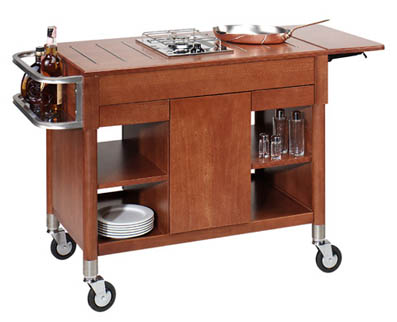
2. Bussing Trolley
- Used to gather soiled dishes to be carried to the dishwashing area.
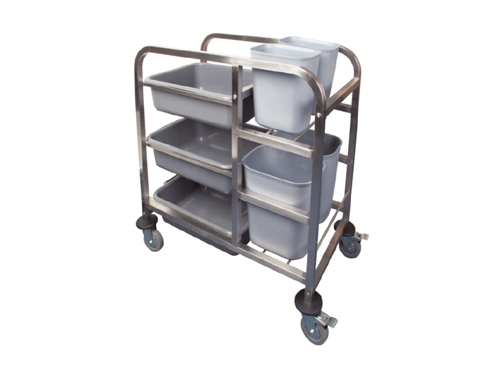
3. Folding side tray
- A portable folding tray where “ready to serve plated food” is assembled, then served at the guest’s table. It is placed right beside the guest table.
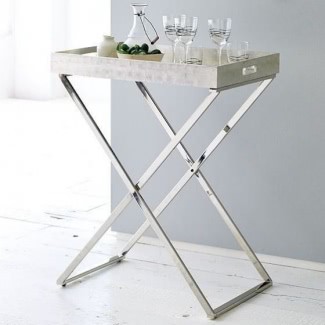
4. Glass Divider rack (Plastic or Wired)
- Used to store glasses. The divider in the rack is designed to prevent glass to glass contact which can cause breakage.
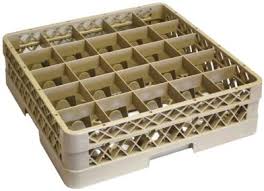
5. China rack
- Used for racking and storage of china wares.
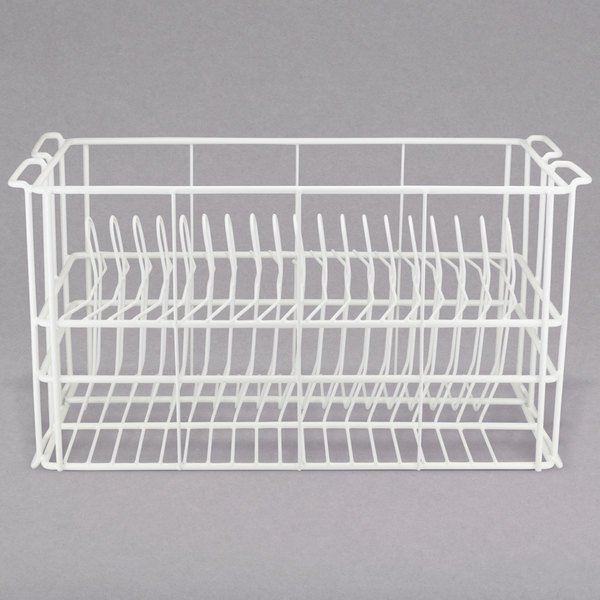
6. Cutlery rack
- Rack for cutleries. It can be thermal or laminate divider.
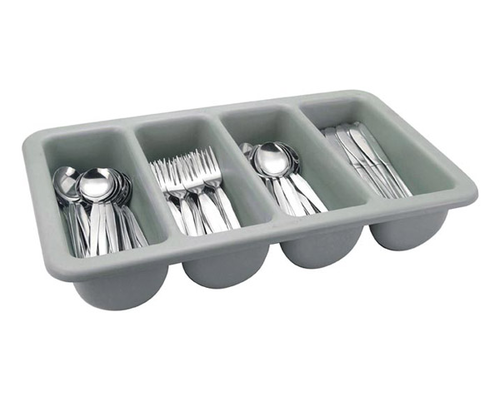
7. Service trays
- Used in assembling and serving food and drinks.
It include round, rectangular and oval tray.
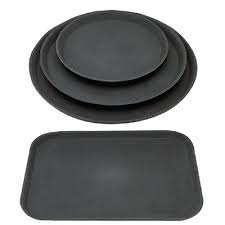
8. Menu stand and Table number
- Used to identify each table in the dining area
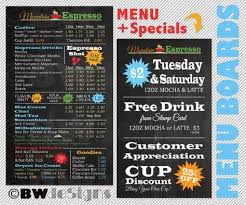
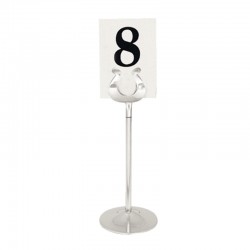
9. Change tray/Bill tray and Bill folder
- Used to place the payment, change or even tip from the customer’s total bill
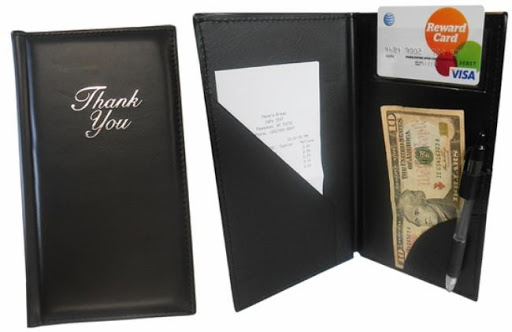
10. Flower vase (for centerpiece)
- Used to accentuate the tables in the dining area
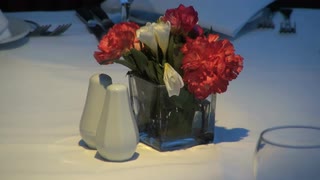
11. Salt/Pepper shaker (cruet set)
- Containers for condiments
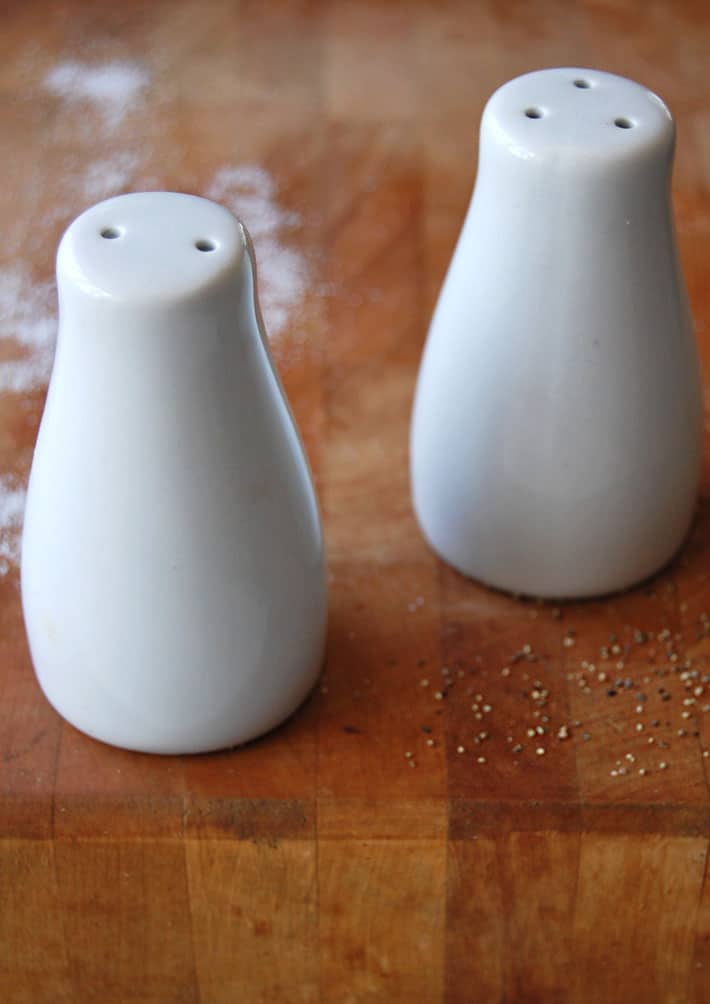
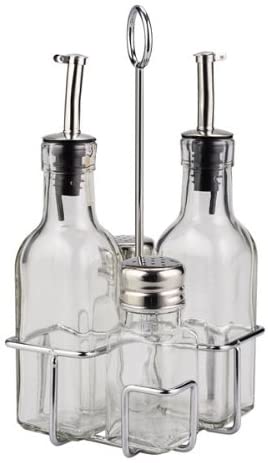
3.2 Table appointments
- It implements used for dining which consist of linen, silverware and/or flatware, dinnerware or chinaware, glassware and the centerpiece.
1. Chinaware/Dinnerware/Plate ware/Crockery
- Any item in the dining room that are soup plate, service plates, saucer, bread plate, dinner plate, etc.
- It is made up of different materials, this includes the following:
a. Ceramic- it includes earth materials such as sand and other minerals and is processed by cooking or baking.
b. Earthenware- it is produced in the UK in vast quantities and is the cheapest and least durable plate. Its main uses are in institutional catering where price rather than durability is main consideration.
c. Stoneware- this is a natural ceramic material traditionally made in the UK and fired at a very high temperature, about 120 degrees Celsius. It is non-porous and extremely durable with high thermal and shock resistance.
d. Porcelain- this is of completely different composition with semi-translucent body, normally blue/grey, and has a high resistance to chipping.
e. Melamine- it is a chemical name for plastic dinnerware.
Different types of dinnerware:
a. Show plate- it is also called as Place plate. It measures 12”-14”in diameter and is used as an underliner in formal dinner.
b. Dinner plate- it is used for main course. Usually, it measures 10”-11” in diameter.
c. Soup plate- it is used for both cold and hot soup. Usually, it measures 9” in diameter.
d. Fish plate- it is used for fish dishes. Usually, it measures 8.5” in diameter.
e. Salad plate- it is used for salads. Usually, it measures 8” in diameter.
f. Dessert plate- it is used for sweets. Usually, it measures 7” in diameter.
g. Bread plate- it is used for breads and buns. Usually, it measure 6” in diameter.
h. Saucer- it is used as an underliner for coffee cup. Usually, it measures 4” in diameter.
List of crockery items:
a. Cream container- contains creamer that serves a condiments for coffee or tea.
b. Sugar container- contains sugar that serves a condiments for coffee or tea
c. Milk jug- contains milk that serves a condiments for coffee or tea
d. Coffee pot- used to serve brewed coffee for customers
e. Tea pot- used to serve brewed tea for customers
f. Coffee cup and saucer- an appointment used for serving coffee
g. Demitasse cup and saucer- an appointment used for serving expresso or tea
h. Cereal bowl- an appointment used for English breakfast of which it includes cereal.
i. Monkey dish- an appointment used for dipping sauces
j. Bouillon cup and Consommé cup- an appointment used for thin or clear soup
k. Egg holder/Coupe- an appointment used to hold soft boiled eggs
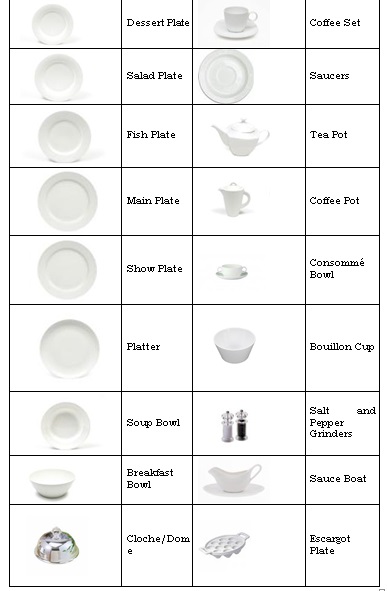
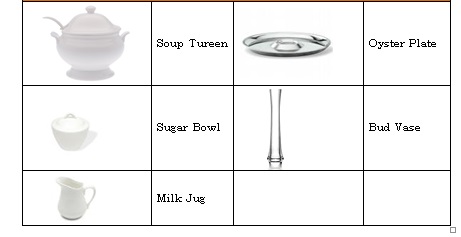
2. Tableware (Flatware/Cutlery/Hollow-ware)
- Flatware denotes all forms of spoon and fork
- Cutlery refers to knives and other cutting implements
- Hollow-ware consists of any item made from silver, apart from the two previous tableware
- It is made either in silver or in stainless steel.
Different tableware:
1. Forks
· Dinner fork- 4 prongs
· Fish fork (webbed fork)- 4 prongs
· Salad fork- 4 prongs
· Oyster fork- 3 prongs
· Cocktail fork- 3 prongs
· Dessert fork- 3 prongs
· Escargot fork- 2 prongs
Relish/Pickle fork- 2 prongs
2. Knives
· Dinner knife
· Steak knife (corrugated)
· Fish knife
· Salad knife
· Dessert knife
· Butter knife/butter spreader
· Cheese knife
3. Serving implements
· Ladle
· Cake server
· Serving spoon
· Serving fork
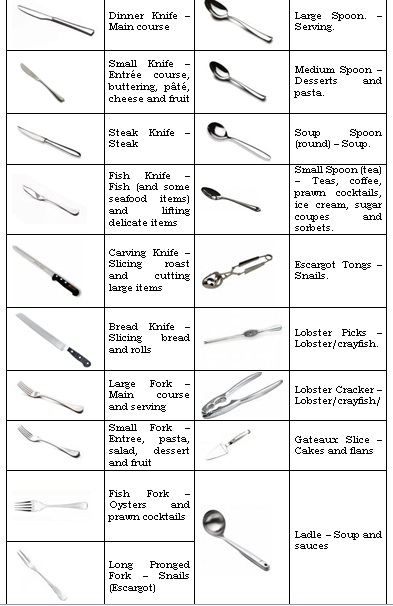
3. Glassware
- It is used for the different beverages served in the restaurant.
- There are different types of glassware, these include the following:
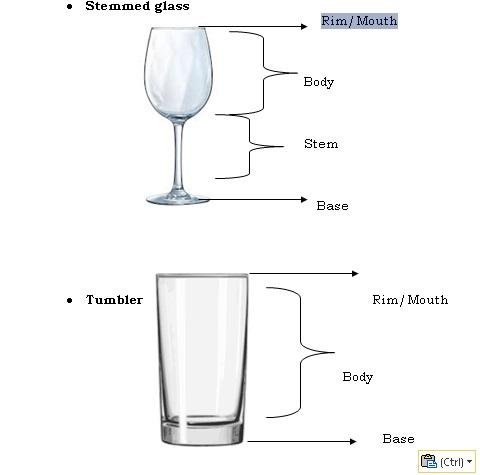
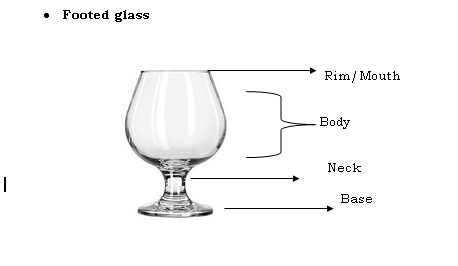
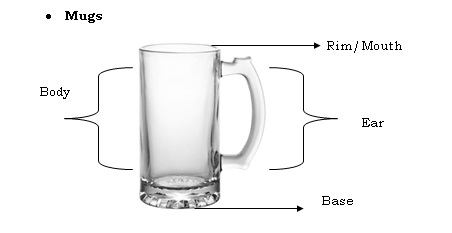
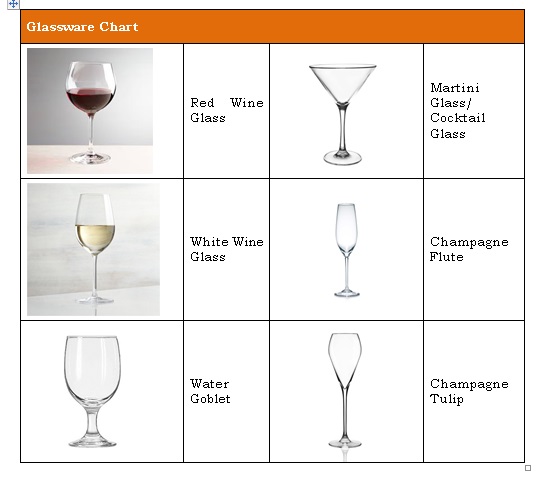
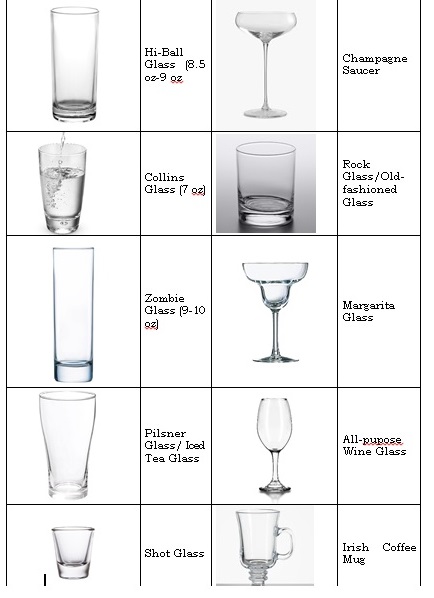
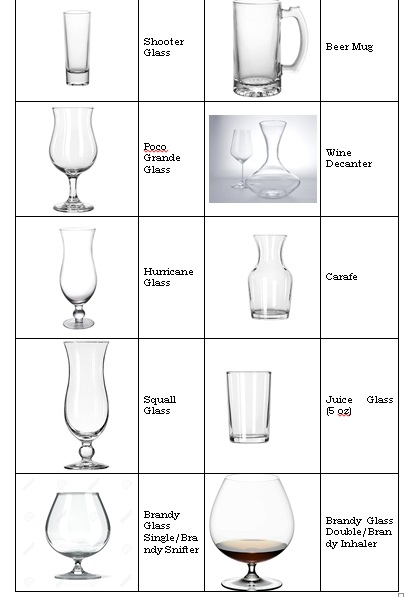
4. Linen
- It applies to any fabric or mat, used for a cloth cover in the dining table with the accompanying napkin.
- It should be durable and serviceable, attractive and suited to other appointments, reasonably priced and easily laundered.
- There are different linens used in a restaurant, these includes:
· Tablecloth- a material used to cover tables for the dining room
· Silence cloth- a material placed on the table under the table cloth used to avoid noise, to avoid breakages, to make the table fold beautifully
· Napkins- should always match or complement the table cloth. There are different sizes used according to its purpose.
· Place mats- it must be large enough to hold the entire place, setting should hold the silverware, napkin, china; edge should be at the edge of the table
· Table runners- pieces of cloth placed across the table to accommodate at least two setting
|
ITEMS |
LINEN SIZE
|
|
I. Toppers |
|
|
A. Round tables a. 72” in diameter b. 60” c. 54” d. 36” |
(diameter size) 120 inches 110 inches 96 inches 54 inches |
|
B. Rectangular tables a. 36” X 72” b. 18” X 72” Square Table 3’ Slip Cloth |
108” x 72” 108 “ x 36” 72” x 72” 36” x 36” |
|
C. Crescent tables a. 54” x 72” |
108” x 96” |
|
D. Half moon 36 inches |
2” x 54” |
|
II. Cloth Napkin/ Table Napkin · For dinner · For cocktail |
18” x 20” 4” x 8”
|
|
III. Place mat |
14” x 20”
|
|
IV. Skirting for tables 36” x 72” |
72” x 308” |
3.3 SANITATION AND SAFETY STANDARDS IN HANDLING SERVICE EQUIPMENT
A. Rules in Sanitation and Handling of Food and Beverage Service Equipment
1. Store food products immediately after they are received in their appropriate temperature.
2. Use proper personal hygiene by washing hands thoroughly for 20 seconds with soap and water before and after handling food.
3. Use only clean utensils such as ladles and tongs when handling food. Do not touch or handle with bare hands.
4. Dispose unserved or unsealed food items that are not consumed.
5. Transfer opened canned foods and juices in sealed glass or stainless container and label them (name, expiration date.
6. Don’t mix old batch of food with new batch. Use separate containers with cover and put labels.
7. Store ready to eat foods above raw foods in cooler, if necessary.
8. Follow FIFO (First In, First Out)
9. All service equipment must be wiped dry with clean wiping cloths.
10. Equipment should not be exposed to contamination. Keep them in close drawers or cabinets, not exposed to open air and dirt.
11. Use scooper for serving ice, serving spoon and fork for dishing out foods.
12. When setting up cutlery and glasses, carry them in trays or place them inside a cloth napkin
13. Never serve food and cutlery that have fallen on the floor.
14. Always wash and wipe dry food containers before using them.
15. Check service station for cleanliness and possible pest infestation. Keep station neat, clean and free of foul odour.
16. Hold fork by the handle, not the tines.
17. Hold glass at the base or stem of the glass, not inside or by the lid.
18. Hold cup by the handle, not at the rim.
19. Hold plate with thumbs under the plate.
B. Rules in Handling of Food and Beverage Service Equipment
1. Use appropriate trays during actual service and bussing.
2. Decoy System should be followed in stacking and storing equipment.
3. Use appropriate door for entry and exit. A separate door for entering and going out should be installed to prevent collisions, which cause accident.
4. Report potential hazards immediately, such as broken tiles. LPG gas with leaks, malfunctioning equipment, etc.
5. Follow manufacturer’s instructional procedures regarding the proper use of all appliances.
6. Place heavy items at the center of the tray to keep it balanced.
7. Let the tray rest on the shoulder with the palm of the hand supporting the tray underneath. Rest the elbow close to the hip when carrying a tray.
8. Make sure the bottom of the tray is clean.
9. Bend the knees not the back, when picking up tray and when putting it down.
C. Some Cause of Breakages.
1. Mechanical Impact
- Results from an object contact, stacking up glassware and hollowware into more than acceptable height; or stacking different sizes of china and plateware together which could cause breakages.
2. Thermal Shock
- The abrupt exposure of breakable equipment from cold to hot temperature or vice versa, resulting in cracks or breakage.
3. Improper Handling and Misuse of Equipment
- Using equipment for a purpose other than what is intended for.
4. Improper Racking and Stacking
- Stacking glasses and stacking chinaware that are different sizes and shapes.
5. Lack of presence of mind
- Results in an accident wherein personnel are inattentive.
6. Environmental Factors
- The presence of safety hazards that can cause accident.